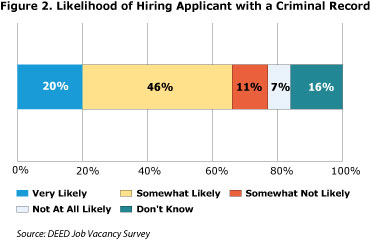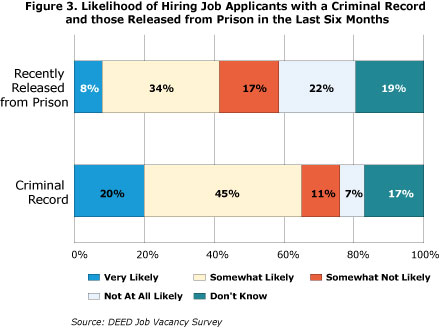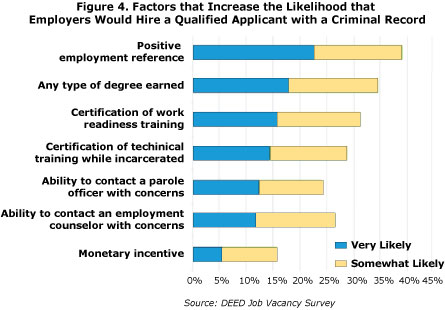by Mark Schultz
February 2020
New survey shows tight labor market may be making hiring practices more inclusive
Minnesota's tight labor market may encourage more employers to consider hiring people with a criminal record, according to results of a recent survey. The Minnesota Department of Corrections (DOC), in collaboration with the Minnesota Department of Employment and Economic Development (DEED), surveyed Minnesota employers, receiving responses from 357 employers in every industry sector, of all sizes and from across Minnesota. In addition to showing employers' willingness to hire people with a criminal record, the survey highlights helpful steps that could be taken by people with a criminal record and those who are supporting their full inclusion in the workforce.
Among the motivations that employers have when it comes to hiring people with a criminal record, 92% were "very much" or "somewhat" motivated by hiring the best candidate for the job, followed by 62% who were "very much" or "somewhat" motivated by their struggle to fill the job vacancies they have. These responses point to employers' willingness to hire a person with a criminal record in order to fill in-demand positions with skilled employees during this tight labor market (Figure 1).

Minnesota is in a lengthy labor force shortage, as evidenced by job vacancy data, which has shown more job openings than people looking for work since 2017. The most recent data, from the second quarter of 2019, show there are nearly 50,000 more job vacancies than there are unemployed job seekers in the state. The current job seeker-per-vacancy ratio is 0.7 to 1, meaning that for every 10 job openings there are only seven unemployed job seekers. The labor shortage is statewide, with all six planning regions showing a job seeker-per-vacancy ratio of 1:1 or lower (Table 1). As employers struggle to fill their job openings, they may find it beneficial to consider hiring individuals they may have overlooked in the past, including those who have been previously incarcerated and others with a criminal record.
| Region | 2nd Quarter 2019 | ||
|---|---|---|---|
| Vacancies | Unemployed | Job Seekers per Vacancy Ratio | |
| Minnesota | 146,513 | 98,300 | 0.7 |
| Central | 13,434 | 13,621 | 1.0 |
| Northwest | 13,020 | 11,791 | 0.9 |
| Northeast | 7,885 | 7,288 | 0.9 |
| Metro | 86,044 | 49,838 | 0.6 |
| Southeast | 13,672 | 8,373 | 0.6 |
| Southwest | 12,458 | 7,390 | 0.6 |
| Source: DEED Job Vacancy Survey and Local Area Unemployment Statistics | |||
According to the 2019 Minnesota DOC Adult Prison Populations Summary report, there are currently 9,479 individuals incarcerated in Minnesota correctional facilities. Of those, only 140 are serving life sentences without the possibility of parole, meaning that the vast majority will eventually be released. For example, in 2018 there were 8,250 individuals released from prison and placed on supervised release/parole into community programs or discharged altogether. The number of individuals released from Minnesota Correctional Facilities fluctuates from year to year, but in total the state has released close to 90,000 individuals over the past decade. In all, it's estimated that between 231,000 and 291,000 Minnesotans — about 6 to 7 percent of the state's adults – have a felony record.
DOC and DEED conducted the survey of Minnesota employers to help understand perceptions and practices regarding the hiring of applicants who have a criminal record. The survey informs work being done through the Minnesota Statewide Initiative to Reduce Recidivism (MNSIRR), a collaboration of state and county agencies, community service providers and stakeholders to implement policies and practices that help prevent previously incarcerated people from returning to prison.
Two-thirds of Minnesota employers surveyed stated that they were "very" or "somewhat likely" to hire someone with a criminal record (Figure 2). In addition, 63% of employers who responded stated that they would consider a person with a criminal record for all positions, while an additional 16% consider it only for some positions.

According to employer comments, the likelihood of hiring someone with a criminal record varied not only depending on the position, but also the type of crime (considered by 71% of employers), severity of the crime (75%), and the length of time since the crime was committed (71%).
Individuals who have been released from prison in the last six months were perceived as less desirable applicants than others with a criminal record. However, 42% of the employers surveyed stated that they were "very" or "somewhat likely" to hire an individual who has been released from prison in the last six months (Figure 3). Employers were also asked what, if anything, would change their mind about hiring a qualified individual who has been released from incarceration in the last six months. Of the open-ended responses, 36% said that the type of crime the individual committed would change their mind, while 10% stated that experience and personal and/or professional references would. Only 18% of the employers surveyed stated that nothing would change their mind. In a tight labor market, employers are looking for workers. As one medium-sized employer stated, "We are looking for the best qualified applicant. We're very open. We've hired people with criminal records."

Still, the results clearly show that having served "hard time" carries a stigma that has the capability to become an individual's "master status," which, according to the Open Education Sociology Dictionary, is "the primary identifying status of an individual that shapes an individual's interactions and relationships with others and dominates all other statuses." Subsequently, this stigma/master status can be one of the most difficult employment barriers that individuals face, trumping all other statuses. Therefore, one huge hurdle to overcome is finding that first job after release. Gaining that first job can open doors to overcome that stigma/master status and replace it with more prosocial ones such as that of a hard worker and valuable employee. In theory, finding "any job" is the first step, followed by finding a "better job", and then moving onto a "career".
According to the survey, of the factors that increase the likelihood that employers would hire a qualified applicant with a criminal record, the largest percentage of employers (just under 40%) stated that a positive employment reference was either "very" or "somewhat likely" to increase their likelihood to hire. Therefore, it's important for people with a criminal record to have ways to earn a positive employment reference, including potentially through work programs during incarceration. Regardless of the type of job that an individual initially takes after release (the "any" job), it is critical for the individual to ensure they work hard, follow directions, and be a great employee overall to secure a positive employment reference when they are ready to apply for future positions.
Employers mentioned other factors, including having previous work experience, having the skills necessary to do the job, how long the applicant was at their previous job, gaps in employment, and attendance.

Fortunately, the correctional facilities under the DOC offer employment opportunities for incarcerated individuals. MINNCOR Industries was established in 1994 with the goal of "providing offender job skill training, meaningful employment, and teaching proper work habits – without burdening the taxpayer." MINNCOR offers printing and laundry services as well as 18 product lines such as correctional and high visibility garments, mattresses and pillows, library, office and residential furniture, safety products, cabinets and casework, and custodial products. MINNCOR also offers sub-contract labor in manufacturing so that companies can utilize the skills of incarcerated workers in a "variety of trades and services, including, but not limited to, assembly, cabinet making, packaging, sewing, and wood fabrication." (See Table 2.)
| Facility | Products/Services | Sub-Contract Labor |
|---|---|---|
| Faribault | Wood Furniture, Laundry, Plastics, Custodial Products | Yes |
| Moose Lake | Textiles, Printing | Yes |
| Oak Park Heights | Centralized Canteen | No |
| Rush City | License Plates, Stickers | Yes |
| Shakopee | Textiles, Safety Products | Yes |
| Stillwater | Warehousing, Logistics, Distribution | Yes |
| Source: MINNCORR | ||
In addition, several Minnesota Correctional Facilities offer incarcerated individuals the opportunity to take advantage of their time spent confined by participating in a wide variety of training programs, including training in carpentry, drywall installation, heavy equipment operation, machine technology, welding, and much more. As detailed in Table 3, depending on the location where the individual is incarcerated there are a variety of training programs available – training programs that could provide the skills needed to be more competitive for employment upon release.
| Training Program | Correctional Facility | |||||||
|---|---|---|---|---|---|---|---|---|
| Faribault | Lino Lakes | Moose Lake | Oak Park Heights | Rush City | St. Cloud | Shakopee | Stillwater | |
| Barbering License Preparation | X | X | ||||||
| Business Management | X | |||||||
| Cabinetmaking | X | X | ||||||
| Carpentry | X | X | ||||||
| Computer Careers | X | X | X | X | X | |||
| Computer Network Cabling | X | X | ||||||
| Cosmetology License Preparation | X | |||||||
| Drywall Installation | X | |||||||
| Floor Covering | X | |||||||
| Heavy Equipment Operator | X | X | ||||||
| Masonry | X | |||||||
| Mechanical Design and Drafting | X | X | ||||||
| Machine Technology | ||||||||
| Painting and Decorating | X | |||||||
| Welding | X | |||||||
| Source: Minnesota Correctional Education Center 2016-2018 Master Academic Plan | ||||||||
These employment and training options offer opportunities to learn new skills and gain work experience while serving time in prison, thus making the individual more attractive as a potential employee and saving the employer the time and the cost that it takes to train a new employee.
A criminal record background check is required for at least some positions they hire for, according to 79% of surveyed employers. Most employers who require a background check conduct it after a conditional job offer (51%). Another 36% conduct a background check after the interview and before any job offer. Unfortunately, 18% of employers surveyed ask about a person's criminal record on the job application. This is a violation of the Ban the Box law, which since 2014 bars all Minnesota employers from asking about criminal record on a job application and requires an employer to wait until later in the hiring process, such as after a job interview or after a conditional offer, before asking the applicant about their criminal record or conducting a criminal background check.
The survey results also show a great deal of opportunity to engage employers in a discussion about the benefits of hiring applicants who have served time in prison. For example, 85% of the employers surveyed were not aware of any programs or services that would assist them in hiring people with a criminal record. However, 61% of employers stated that they were interested in using programs to support hiring job seekers with a criminal record.
With the state facing a significant labor force shortage as shown by the low job seeker-per-vacancy ratio, employers are finding the need to change their hiring practices to be more inclusive. Many employers are recognizing the benefits of considering Minnesotans with a criminal record who may have the needed skills, experience, and training. As one Minnesota employer surveyed put it: "Everybody deserves a chance. If you made a bad decision as a younger person, you shouldn't have to pay for it your entire life."